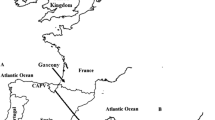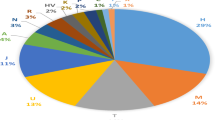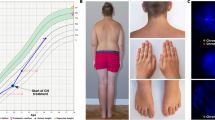Abstract
The c.1544+1G>A substitution at the 5′ splice donor site of intron 15 of the ITGA2B gene, called the French Gypsy mutation, causes Glanzmann thrombasthenia, an inherited hemorrhagic disorder transmitted as an autosomal recessive trait and characterized by an altered synthesis of the platelet αIIbβ3 integrin. So far, this mutation has only been found in affected individuals originating from French Manouche families, strongly suggesting a founder effect. Our goal was to investigate the origin of the French Gypsy mutation. We estimated the age of the mutation by a likelihood-based method that uses the length of the shared haplotypes among a set of patients. For this, we genotyped 23 individuals of Manouche origin; consisting of 9 Glanzmann thrombasthenia patients homozygous for the French Gypsy mutation, 6 heterozygous carriers and 8 homozygous wild-type individuals. They were genotyped for four single-nucleotide polymorphisms using high-resolution melting curve analysis, and for two CA repeats in the BRCA1 and THRA genes at chromosome 17, using fragment analysis gels. We found that a haplotype of five polymorphic loci covering a 4-cM region was strongly associated with the French Gypsy mutation, suggesting a founder effect. The estimated age of this founder mutation was 300–400 years (range 255–552 years). Thus, all carriers of the French Gypsy mutation c.1544+1G>A at intron 15 descended from a common ancestor 300–400 years ago.
Similar content being viewed by others
Log in or create a free account to read this content
Gain free access to this article, as well as selected content from this journal and more on nature.com
or
References
Nurden AT : Glanzmann thrombasthenia. Orphanet J Rare Dis 2006; 1: 10.
Seligsohn U, Rososhansky S : A Glanzmann's thrombasthenia cluster among Iraqi Jews in Israel. Thromb Haemost 1984; 52: 230–231.
Awidi AS : Increased incidence of Glanzmann's thrombasthenia in Jordan as compared with Scandinavia. Scand J Haematol 1983; 30: 218–222.
Piippo K, Laitinen P, Swan H et al: Homozygosity for a HERG potassium channel mutation causes a severe form of long QT syndrome: identification of an apparent founder mutation in the Finns. J Am Coll Cardiol 2000; 35: 1919–1925.
Heyer E : One founder/one gene hypothesis in a new expanding population: saguenay (Quebec, Canada). Hum Biol 1999; 71: 99–109.
Levy JM, Mayer G, Sacrez R, Ruff R, Francfort JJ, Rodier L : Glanzmann-Naegeli thrombasthenia. Study of a strongly endogamous ethnic group. Ann Pediatr (Paris) 1971; 18: 129–137.
Levy JM, Stoll C, Gardea A, Bigel P : Clinics and genetics of Glanzmann's thrombasthenia (author's translation). Nouv Rev Fr Hematol 1976; 16: 399–405.
d'Oiron R, Menart C, Trzeciak MC et al: Use of recombinant factor VIIa in 3 patients with inherited type I Glanzmann's thrombasthenia undergoing invasive procedures. Thromb Haemost 2000; 83: 644–647.
Martin I, Kriaa F, Proulle V et al: Protein A sepharose immunoadsorption can restore the efficacy of platelet concentrates in patients with Glanzmann's thrombasthenia and anti-glycoprotein IIb-IIIa antibodies. Br J Haematol 2002; 119: 991–997.
Schlegel N, Gayet O, Morel-Kopp MC et al: The molecular genetic basis of Glanzmann's thrombasthenia in a gypsy population in France: identification of a new mutation on the alpha IIb gene. Blood 1995; 86: 977–982.
de la Salle C, Schwartz A, Baas MJ, Lanza F, Cazenave JP : Detection by PCR and HphI restriction analysis of a splice site mutation at the 5' end of intron 15 of the platelet GPIIb (alphaIIb integrin) gene responsible for Glanzmann's thrombasthenia type I in Gypsies originating from the Strasbourg area. Thromb Haemost 1995; 74: 990–991.
Ruan J, Peyruchaud O, Nurden P et al: Family screening for a Glanzmann's thrombasthenia mutation using PCR-SSCP. Platelets 1998; 9: 129–136.
Vinciguerra C, Bordet JC, Beaune G, Grenier C, Dechavanne M, Negrier C : Description of 10 new mutations in platelet glycoprotein IIb (alphaIIb) and glycoprotein IIIa (beta3) genes. Platelets 2001; 12: 486–495.
Jacquelin B, Tuleja E, Kunicki TJ, Nurden P, Nurden AT : Analysis of platelet membrane glycoprotein polymorphisms in Glanzmann thrombasthenia showed the French gypsy mutation in the alphaIIb gene to be strongly linked to the HPA-1b polymorphism in beta3. J Thromb Haemost 2003; 1: 573–575.
Nurden AT, Nurden P : Rebuttal: the French Gypsy mutation does not give rise to a particularly mild form of Glazmann's thrombasthenia. J Thromb Haemost 2003; 1: 2459.
Kunicki TJ, Pidard D, Cazenave JP, Nurden AT, Caen JP : Inheritance of the human platelet alloantigen, PlA1, in type I Glanzmann's thrombasthenia. J Clin Invest 1981; 67: 717–724.
Fiore M, Nurden AT, Vinciguerra C, Nurden P, Pillois X : Rapid diagnosis of the French gypsy mutation in Glanzmann thrombasthenia using high resolution melting analysis. Thromb Haemost 2010; 104: 1076–1077.
French DL, Coller BS, Usher S et al: Prenatal diagnosis of Glanzmann thrombasthenia using the polymorphic markers BRCA1 and THRA1 on chromosome 17. Br J Haematol 1998; 102: 582–587.
Austerlitz F, Kalaydjieva L, Heyer E : Detecting population growth, selection and inherited fertility from haplotypic data in humans. Genetics 2003; 165: 1579–1586.
PHASEv2.1. www.stat.washington.edu/stephens/software.html.
International HapMap Consortium: The International HapMap Project. Nature 2003; 426: 789–796.
French Senate report. http://www.senat.fr/rap/l96-283/l96-2831.html.
Mor-Cohen R, Rosenberg N, Peretz H et al: Disulfide bond disruption by a beta3-Cys549Arg mutation in six Jordanian families with Glanzmann thrombasthenia causes diminished production of constitutively active alphaIIbbeta 3. Thromb Haemost 2007; 98: 1257–1265.
Rosenberg N, Hauschner H, Peretz H et al: A 13-bp deletion in alpha(IIb) gene is a founder mutation that predominates in Palestinian-Arab patients with Glanzmann thrombasthenia. J Thromb Haemost 2005; 3: 2764–2772.
Fraser A : The Gypsies. Blackwell Publishers: Oxford, 1992.
Gresham D, Morar B, Underhill PA et al: Origins and divergence of the Roma (gypsies). Am J Hum Genet 2001; 69: 1314–1331.
Kalaydjieva L, Gresham D, Calafell F : Genetic studies of the Roma (Gypsies): a review. BMC Med Genet 2001; 2: 5.
Liegeois J-P : Roma, Gypsies, Travellers. Council of Europe Press: Strasbourg, 1994.
Morar B, Gresham D, Angelicheva D et al: Mutation history of the Roma/Gypsies. Am J Hum Genet 2004; 75: 596–609.
Reyniers A : Manouches. Tzigane studies 2006; 26: 1–144.
Acknowledgements
We thank Drs M-C Alessi, J-J Choulot, S Clayssens, V Doireau, Y Gruel, D Lacombe and M Micheau for kindly providing DNA samples from Manouche families; This study was financed by INSERM (ANR-08-GENO-028–03) and from a subvention accorded to Alan T Nurden by GIS-Maladies Rares.
Author information
Authors and Affiliations
Corresponding author
Ethics declarations
Competing interests
The authors declare no conflict of interest.
Additional information
Supplementary Information accompanies the paper on European Journal of Human Genetics website
Supplementary information
Rights and permissions
About this article
Cite this article
Fiore, M., Pillois, X., Nurden, P. et al. Founder effect and estimation of the age of the French Gypsy mutation associated with Glanzmann thrombasthenia in Manouche families. Eur J Hum Genet 19, 981–987 (2011). https://doi.org/10.1038/ejhg.2011.61
Received:
Revised:
Accepted:
Published:
Issue date:
DOI: https://doi.org/10.1038/ejhg.2011.61
Keywords
This article is cited by
-
A pathogenic variant in CHEK2 shows a founder effect in Portuguese Roma patients with thyroid cancer
Endocrine (2021)
-
Clinical utility gene card for: Glanzmann thrombasthenia
European Journal of Human Genetics (2012)



